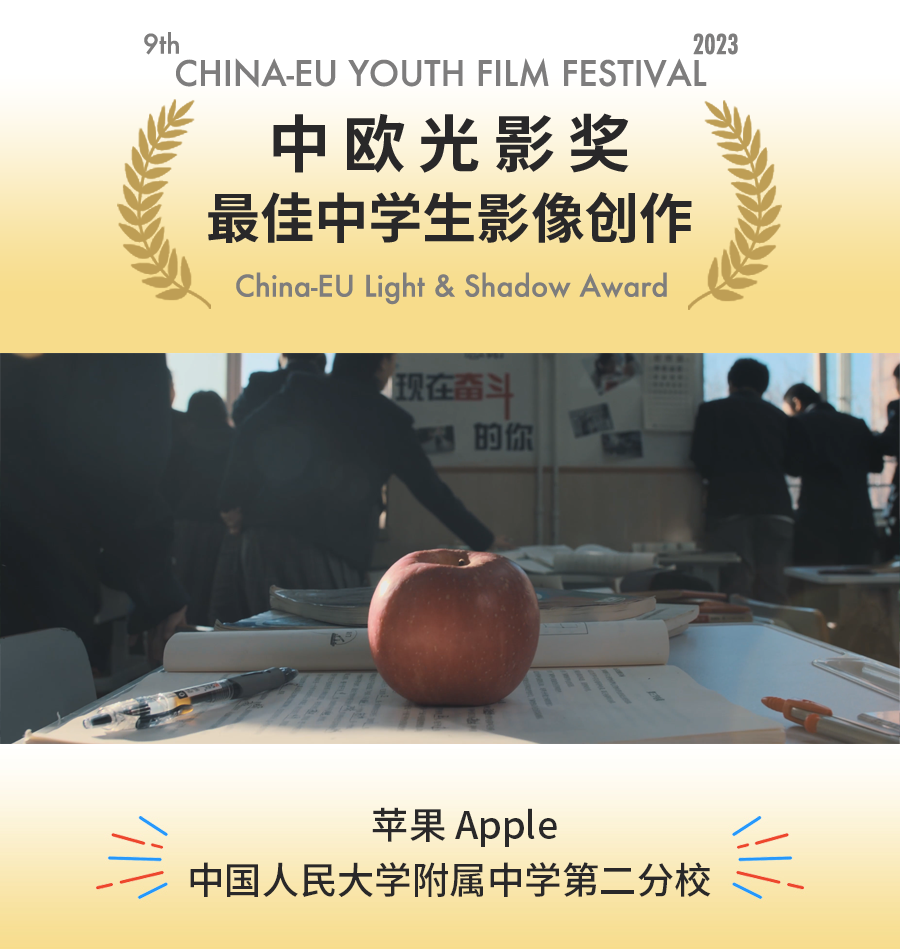
Chufeng Tang Director
Currently enrolled as a senior student
Aspiring filmmaker with a passion for directing, aiming not just for the art but also for financial success (❁´◡`❁)✲゚
Synopsis
A girl, Shi Yi, tries to fight against bullying in school in many ways, but all of them fail. However, a chance encounter with another girl saves each other at the same time…
Why did you choose an apple as the central theme for the entire film? What special significance does the apple hold?
Chufeng Tang:I believe the apple itself carries a sense of “peace.” It foreshadows the reconciliation of the two main characters, hinting at a fulfilling resolution to the story. Additionally, the apple is a common element in daily life, making it a suitable symbol to thread through the entire plot.
The overall tone of the film is relatively subdued, but there is a refreshing and picturesque scene of the female protagonist, Shiyi, alone under a cherry blossom tree. How did you approach this particular scene?
Chufeng Tang:I think there are two considerations: one is to bring out the overall direction of this story. On the other hand, we want to use this as a symbol to tell the audience that we are now entering Shi Yi’s inner world. By visualizing her inner self, lead to the following story. Of course, the idea of cherry blossoms can be realized because it happened to coincide with this season, so we seized this scene.
Why did you choose to make a film centered around the theme of campus violence? How did you focus the film’s theme specifically on campus violence?
Chufeng Tang:Overall, it is due to both opportunities and limitations considerations.
In terms of opportunities, this theme may indeed be quite clich é d, but I believe that even though campus violence has improved a lot in recent years, it is still a social issue worth paying attention to. We were very clear in the early stages that we wanted to approach from the perspective of social issues, so we ultimately chose this theme.
In terms of limitations, I may no longer consider this to be a good material selection, but in the middle school stage, under our limited ideas, equipment, and shooting conditions, this may have been the optimal solution at that time. Considering that all members of the crew are in class, our filming time can only be in our spare time, and the venue can only be limited to the school. Therefore, to some extent, this is also the result of our trade-offs.
Because this theme not only fits the current social issues, but also is relatively easy to operate, I chose this to shoot at that time.
Why do you now feel that the choice of this theme wasn’t ideal?
Chufeng Tang:I simply find it somewhat cliché. Since there have likely been many films on this topic before, with better conditions, we might have chosen a more unique theme and script.
Compared to other works with a similar theme, what do you think sets “Apple” apart in terms of innovation?
Chufeng Tang:I think our film takes a somewhat novel perspective. While other films may emphasize resisting campus violence, ours focuses more on the possible reasons behind its occurrence or ways to address it. We want to convey that responding to violence with violence is not the answer. While we address the victims, we also emphasize the importance of paying attention to the perpetrators, placing them on an equally important pedestal. This perspective might be less common in other films.
The opening airplane scene and the flashing traffic lights at the end seem to deliberately use symbolic elements. Could you interpret your thoughts behind these choices in the film production?
Chufeng Tang:Regarding traffic lights, you mentioned that there was a green light at the end, but in fact, there was also a red light earlier. This is actually a relatively simple symbol, expressing the contradictory state of two female protagonists from the beginning to shaking hands and making peace. This is something I think is relatively easy to see.
In addition, I think it’s worth noting that there is a scene in about four minutes where everyone walks in the opposite direction from Shi Yi’s side. I think this can be considered another image. I want to say that although Shi Yi is a victim of bullying, she did not elicit sympathy and resonance from others in the class. People tend to have a mentality of watching the fun and did not show any extra care or concern for her. This kind of retrograde movement is actually a symbol of the helpless feeling in the protagonist Shi Yi’s heart that “the whole world is against me”. I think this is another image in the film.
The film includes some sensitive content, such as specific acts of campus violence and suicide. How did you coordinate with locations and actors and overcome technical difficulties?
Chufeng Tang:I don’t think these were significant issues for us. Perhaps the most significant challenge was training the actors because we are all still students without prior acting experience. This applies to both the main and supporting roles, and we had to put in considerable effort to train and guide them. Additionally, since there were many scenes involving classmates, finding a large number of extras to cooperate was not easy.
As for the shooting, looking back now, some scenes could have been better adjusted to ensure smoother transitions. In retrospect, some shots appear a bit amateurish.
Therefore, I think the shooting itself didn’t pose many problems. The main challenge was with the actors and, of course, time coordination. Since we were all attending classes, we had limited time.
Is there anything particularly memorable for you during the film production process?
Chufeng Tang:The most memorable is probably the scene with the traffic lights. We shot it in the early morning because during the day, there were many cars and people in that location. We had to find a time to avoid traffic, so we started shooting in the early morning. That night was extremely cold, so I have a vivid memory of that.
Another memorable aspect is that when shooting this film, we rented some more advanced equipment that we hadn’t used before, such as a recorder and a slider. As students, we had limited budgets and equipment before, so using this equipment for the first time was quite exciting, and the results exceeded my expectations by far.
What does making a film mean to you?
Chufeng Tang:First and foremost, it’s something I genuinely enjoy. It aligns with my personal interests.
Additionally, through filmmaking, I can, to the best of my ability, provoke thought or provide something enjoyable for others. For example, in “Apple,” while it may not have high artistic value, it focuses more on exploring social issues. Beyond this film, I have directed other films that are more lyrical in nature and don’t directly point out social problems like “Apple” does. So, aside from my personal interests, I also want to convey some emotions or perspectives to the audience, or make them pay attention to some social realities they might not have noticed. I think film making is a more influential way to achieve this, and it has artistic value and effects.
Also, I believe the entire process of film making is a journey of self-improvement for me. Even though I might not be able to enter this industry in the end, I think the experiences accumulated during my growth are valuable and meaningful. I find it necessary for my growth in three main aspects.
When did you become interested in film making? Do you have thoughts about continuing in the industry in the future, or is it just a hobby?
Chufeng Tang:I started getting into photography around the ninth grade, initially limited to still images. In high school, I joined the school’s media club, and from the first year, teachers guided us in making some films. So, I began to be exposed to film and video production, including roles like directing and editing.
I’m not sure if I can truly enter this industry in the future, but since I’m now in my third year of high school and have chosen this as my major, I will definitely continue studying and developing in this direction during my college years.
Personally, I prefer still photography, but I do think there might be better prospects in the future for film and video production. Whether in terms of economic benefits, aesthetic appreciation, or visual experience, filmmaking might bring higher returns and value than still photography. So, I think I can reconsider that when the time comes. After all, my personal aspirations always need to be achieved with a full stomach, right?
